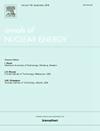Lead-cooled fast reactor SGTR accident pressure wave analysis and structural response
IF 2.3
3区 工程技术
Q1 NUCLEAR SCIENCE & TECHNOLOGY
引用次数: 0
Abstract
Steam Generator Tube Rupture (SGTR) accidents are one of the most serious types of accidents in Lead-cooled Fast Reactors (LFRs). Due to the large pressure and temperature differences between the two sides of the steam generator heat transfer tubes in lead–bismuth fast reactors, combined with the corrosive effects of liquid lead–bismuth eutectic (LBE), steam generator heat transfer tube rupture accidents may occur. In this paper, the SGTR accident in the lead-cooled fast reactor M2LFR-1000 is taken as an example. The computational fluid dynamics (CFD) program is used to simulate the early stage of SGTR accident, and the correctness of the model is verified through experiments. The severity of the accident under different rupture sizes is also assessed. By coupling ANSYS Fluent with ANSYS Structural, the impact of a single heat exchanger tube rupture on neighboring tubes is calculated to evaluate the possibility of chain rupture accidents. The results of the study show that as the pressure wave peak increases with larger rupture sizes, the risk of localized fracture is higher in internally threaded tubes than in smooth tubes, as determined by stress assessment.
铅冷快堆SGTR事故压力波分析及结构响应
蒸汽发生器爆管事故是铅冷快堆中最严重的事故之一。由于铅铋快堆中蒸汽发生器换热管两侧存在较大的压力和温差,再加上液态铅铋共晶(LBE)的腐蚀作用,蒸汽发生器换热管可能发生破裂事故。本文以M2LFR-1000型铅冷快堆发生的SGTR事故为例。利用计算流体力学(CFD)程序对SGTR事故进行了早期模拟,并通过实验验证了模型的正确性。并对不同破裂尺寸下的事故严重程度进行了评价。通过ANSYS Fluent与ANSYS Structural的耦合,计算单个换热器管断裂对相邻管的影响,评估链断裂事故发生的可能性。研究结果表明,压力波峰值随破裂尺寸增大而增大,应力评估结果表明,内螺纹管的局部破裂风险高于光滑管。
本文章由计算机程序翻译,如有差异,请以英文原文为准。
求助全文
约1分钟内获得全文
求助全文
来源期刊

Annals of Nuclear Energy
工程技术-核科学技术
CiteScore
4.30
自引率
21.10%
发文量
632
审稿时长
7.3 months
期刊介绍:
Annals of Nuclear Energy provides an international medium for the communication of original research, ideas and developments in all areas of the field of nuclear energy science and technology. Its scope embraces nuclear fuel reserves, fuel cycles and cost, materials, processing, system and component technology (fission only), design and optimization, direct conversion of nuclear energy sources, environmental control, reactor physics, heat transfer and fluid dynamics, structural analysis, fuel management, future developments, nuclear fuel and safety, nuclear aerosol, neutron physics, computer technology (both software and hardware), risk assessment, radioactive waste disposal and reactor thermal hydraulics. Papers submitted to Annals need to demonstrate a clear link to nuclear power generation/nuclear engineering. Papers which deal with pure nuclear physics, pure health physics, imaging, or attenuation and shielding properties of concretes and various geological materials are not within the scope of the journal. Also, papers that deal with policy or economics are not within the scope of the journal.
 求助内容:
求助内容: 应助结果提醒方式:
应助结果提醒方式:


